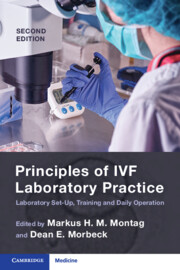Book contents
- Principles of IVF Laboratory Practice
- Principles of IVF Laboratory Practice
- Copyright page
- Contents
- Contributors
- Foreword
- The Evolution of IVF Practice
- Section 1 Starting a New Laboratory and Training Protocols
- Section 2 Pre-procedure Protocols
- Chapter 10 Mouse Embryo Assay for Quality Control in the IVF Laboratory
- Chapter 11 Sperm Survival Assay for Quality Control in the IVF Laboratory
- Chapter 12 Quality Control in the IVF Laboratory
- Chapter 13 Set-Up Procedures for Optimizing Performance in the IVF Laboratory
- Section 3 Gametes
- Section 4 Insemination/ICSI
- Section 5 Fertilization Assessment
- Section 6 Embryo Assessment: Morphology and Beyond
- Section 7 Embryo Cryopreservation
- Section 8 Embryo Transfer
- Section 9 Quality Management
- Index
- References
Chapter 10 - Mouse Embryo Assay for Quality Control in the IVF Laboratory
from Section 2 - Pre-procedure Protocols
Published online by Cambridge University Press: 07 August 2023
- Principles of IVF Laboratory Practice
- Principles of IVF Laboratory Practice
- Copyright page
- Contents
- Contributors
- Foreword
- The Evolution of IVF Practice
- Section 1 Starting a New Laboratory and Training Protocols
- Section 2 Pre-procedure Protocols
- Chapter 10 Mouse Embryo Assay for Quality Control in the IVF Laboratory
- Chapter 11 Sperm Survival Assay for Quality Control in the IVF Laboratory
- Chapter 12 Quality Control in the IVF Laboratory
- Chapter 13 Set-Up Procedures for Optimizing Performance in the IVF Laboratory
- Section 3 Gametes
- Section 4 Insemination/ICSI
- Section 5 Fertilization Assessment
- Section 6 Embryo Assessment: Morphology and Beyond
- Section 7 Embryo Cryopreservation
- Section 8 Embryo Transfer
- Section 9 Quality Management
- Index
- References
Summary
Ensuring proper quality control (QC) in the laboratory is critical to the success of any in vitro fertilization (IVF) programme, as the environment of the laboratory can alter the quality of the embryos produced. The ultimate role of the embryology laboratory is to maintain the inherent viability of the gametes and embryos in an environment outside the female reproductive tract. There is a need for objective, sensitive and reproducible methods and assays for testing materials for embryo toxicity as well as growth promoting and inhibiting factors. The manufacturers test commercially available IVF media and plastic ware and provide the results of their testing with the shipment of supplies. It may be advisable to test media and supplies upon arrival to confirm that nothing occurred during shipping. The suitability of various reagents and materials for use in human IVF can be tested using a range of bioassays. While the most used bioassays for QC in IVF laboratories are the human sperm survival assay and the mouse embryo bioassay (MEA), the one-cell MEA has been consistently shown to be the most sensitive.
Keywords
- Type
- Chapter
- Information
- Principles of IVF Laboratory PracticeLaboratory Set-Up, Training and Daily Operation, pp. 75 - 79Publisher: Cambridge University PressPrint publication year: 2023



